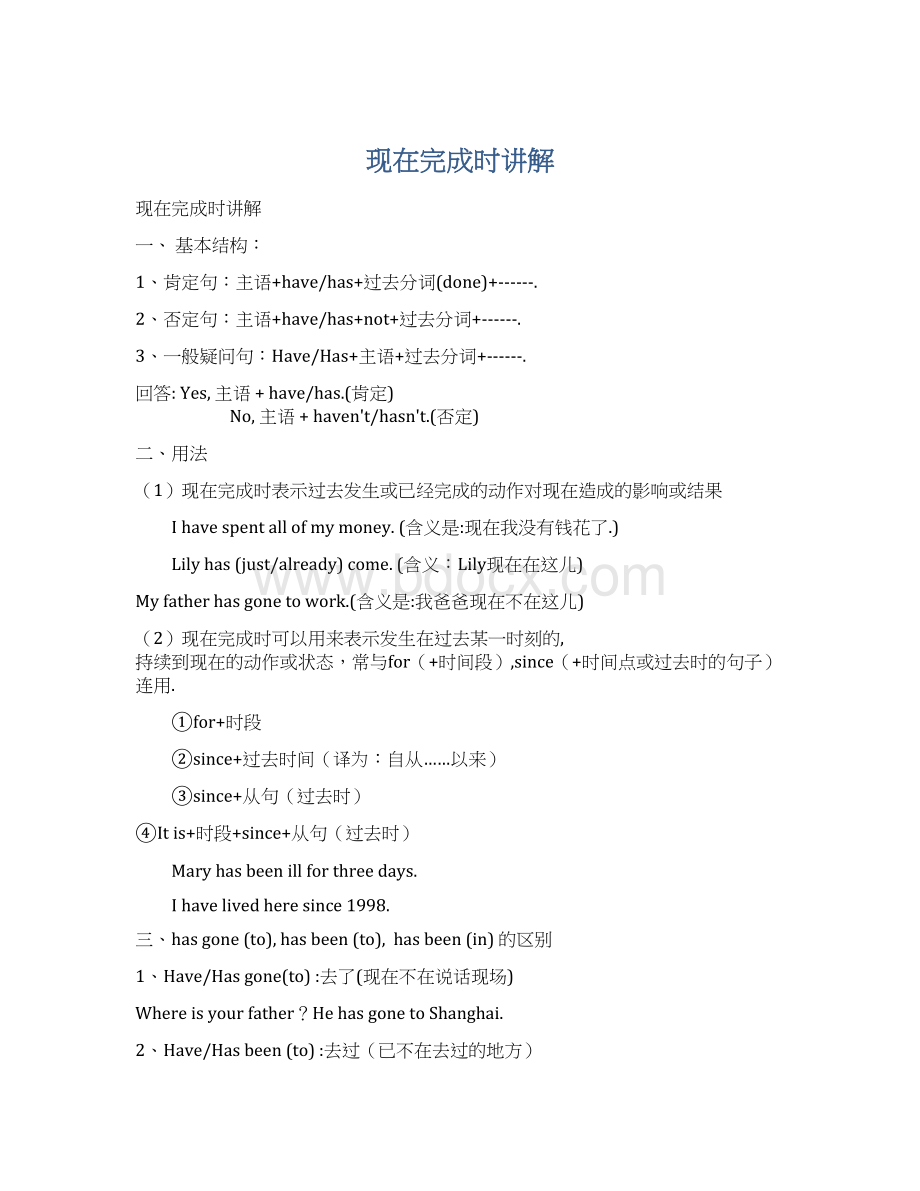现在完成时讲解.docx
《现在完成时讲解.docx》由会员分享,可在线阅读,更多相关《现在完成时讲解.docx(11页珍藏版)》请在冰豆网上搜索。

现在完成时讲解
现在完成时讲解
一、 基本结构:
1、肯定句:
主语+have/has+过去分词(done)+------.
2、否定句:
主语+have/has+not+过去分词+------.
3、一般疑问句:
Have/Has+主语+过去分词+------.
回答:
Yes, 主语 +have/has.(肯定)
No, 主语 +haven't/hasn't.(否定)
二、用法
(1)现在完成时表示过去发生或已经完成的动作对现在造成的影响或结果
I havespent allofmymoney.(含义是:
现在我没有钱花了.)
Lily has(just/already)come.(含义:
Lily现在在这儿)
Myfather hasgone towork.(含义是:
我爸爸现在不在这儿)
(2)现在完成时可以用来表示发生在过去某一时刻的,持续到现在的动作或状态,常与for(+时间段),since(+时间点或过去时的句子)连用.
①for+时段
②since+过去时间(译为:
自从……以来)
③since+从句(过去时)
④Itis+时段+since+从句(过去时)
Maryhasbeenill forthreedays.
Ihavelivedhere since1998.
三、hasgone(to),hasbeen(to),hasbeen(in) 的区别
1、Have/Hasgone(to):
去了(现在不在说话现场)
Whereisyourfather?
HehasgonetoShanghai.
2、Have/Hasbeen(to):
去过(已不在去过的地方)
MyfatherhasbeentoShanghai.
3、Have/hasbeenin:
呆了多久(还在所呆的地方)
MyfatherhasbeeninShanghai fortwomonths./sincetwomonthsago.
四、现在完成时的标志
1、现在完成时的含义之一是过去完成的动作对现在仍有影响,用以下四大标志词可以表达这种含义:
(1) 以already,just和yet为标志
He hasalreadygot herhelp. 他已得到她的帮助。
He hasjustseen thefilm. 他刚刚看过这场电影。
He hasn'tcome back yet. 他还没有回来。
(2) 以ever和never为标志
ThisisthebestfilmI haveeverseen. 这是我曾经看过的最好的一部电影。
He hasneverbeen toBeijing. 他从没有到过北京。
(3)以动作发生的次数为标志
Hesayshe hasbeento theUSA threetimes.他说他已经去过美国三次了。
(4) 以sofar(到目前为止)为标志+before
He hasgot toBeijing sofar. 到目前为止他已到了北京。
Shehaspassedtheexamsofar. 到目前为止她已经通过了考试。
2.过去已经开始的动作一直延续到现在,甚至有可能继续延续下去,我们可以从动作“延续”的特性和“时间”点段的区分入手,进一步学习现在完成时。
①for+时段
②since+过去一个时间点(过去 从句)为标志
注意:
1)现在完成时不能单独与过去的时间状语连用, 如yesterday,lastweek,threeyearsago 等;
五、过去分词
(一)规则动词:
规则动词的过去分词的构成规则与规则动词的过去式的构成规则相同。
(1)一般动词,在词尾直接加“ed”。
work---worked---worked,visit---visited---visited
(2)以“e”结尾的动词,只在词尾加“d”。
live---lived---lived,
(3)以“辅音字母+y”结尾的动词,将"y"变为"i",再加“ed”。
study---studied---studied,cry---cried---cried
(4)重读闭音节结尾,末尾只有一个辅音字母,先双写该辅音字母,再加“ed”。
stop---stopped---stopped,drop---dropped--dropped
(二)不规则动词:
1、AAA型
原型过去式过去分词
burstburstburstcastcastcastcostcostcostcutcutcut
hithithithurthurthurtletletletputputput
setsetsetshutshutshutspreadspreadspread
readreadread read原形发音为/ri:
d/,过去式和过去分词发音为/red/
2、AAB型
beatbeatbeaten
3、ABA型
becomebecamebecomerunranruncomecamecome
特殊情况
4、ABB型
bringbroughtbroughtbuyboughtboughtbuildbuiltbuiltburnburntburnt
catchcaughtcaught
digdugdug
feelfeltfeltfightfoughtfoughtfindfoundfound
hearheardheardholdheldheld
keepkeptkept
laylaidlaidleadledledloselostlost
makemademademeetmetmet
sellsoldsoldshootshotshotsitsatsat standstoodstood
sweepsweptswept
teachtaughttaught telltoldtoldthinkthoughtthought
winwonwon
5、ABC型
beginbeganbegunblowblewblown breakbrokebroken
choosechosechosen
drawdrewdrawndrivedrovedrivendrinkdrankdrunk
flyflewflownforgiveforgaveforgivenforgetforgotforgottenfreezefrozefrozen
givegavegiven growgrewgrown
knowknewknown
rideroderidden riseroserisenringrangrung
shakeshookshakensingsangsungsinksanksunkswimswamswum
swimswamswum
throwthrewthrown
writewrotewritten
六、 瞬间动词(buy,die,join,come,go,leave,join……)不能直接与for/since 连用。
要改变动词
begin-----beon borrow-----keepbuy----have
close-----beclosedcome/arrive/reach/getto-----bein
die----bedead
finish----beover
goout----beout
leave----beaway
open----beopen
★1、have代替buy
Mybrotherhashad(不能用hasbought)thisbikeforalmostfouryears.
★2、用keep或have代替borrow
Ihavekept(不能用haveborrowed)thebookforquiteafewdays.
★3、用be替代become
Howlonghasyoursisterbeenateacher?
★4、用haveacold代替catchacold
Tomhashadacoldsincethedaybeforeyesterday.
★5、用wear代替puton
b)用“be+形容词”代终止性动词
1、be+married代marry2、be+ill代fall(get)ill
3、be+dead代die4、be+asleep代fall(get)asleep
5、be+awake代wake/wakeup6、be+gone代lose,die,sell,leave
7、be+open代open8、beclosed代close/shut
9、be+missing(gone,lost)代lose
c)用“be+副词”代终止性动词
1“be+on”代start,begin
2“be+up”代getup
3“be+back(to)”代returnto,comebackto,gobackto
4“behere(there)”代come(arrive,reach,get)here或go(arrive,reach,get)there等等
d)用“be+介词短语”代终止性动词
1.“bein/at+地点”代替goto/cometo
2.用beinthearmy 代替jointhearmy
3.“bein/at+地点”代替moveto
常用瞬间动词变延续性动词表:
1.havearrivedat/insw.gotto/reachedsw.come/gone/movedtosw.
→havebeeninsw./at…相应的介词
2.havecome/goneback/returned→havebeenback
3.havecome/goneout→havebeenout
4.havebecome→havebeen
5.haveclosed/opened→havebeenclose/open
6.havegotup→havebeenup;
7.havedied→havebeendead;
8.haveleftsw.→havebeenawayfromsw.
9.havefallenasleep/gottosleep→havebeenasleep;
10.havefinished/ended/completed→havebeenover;
11.havemarried→havebeenmarried;